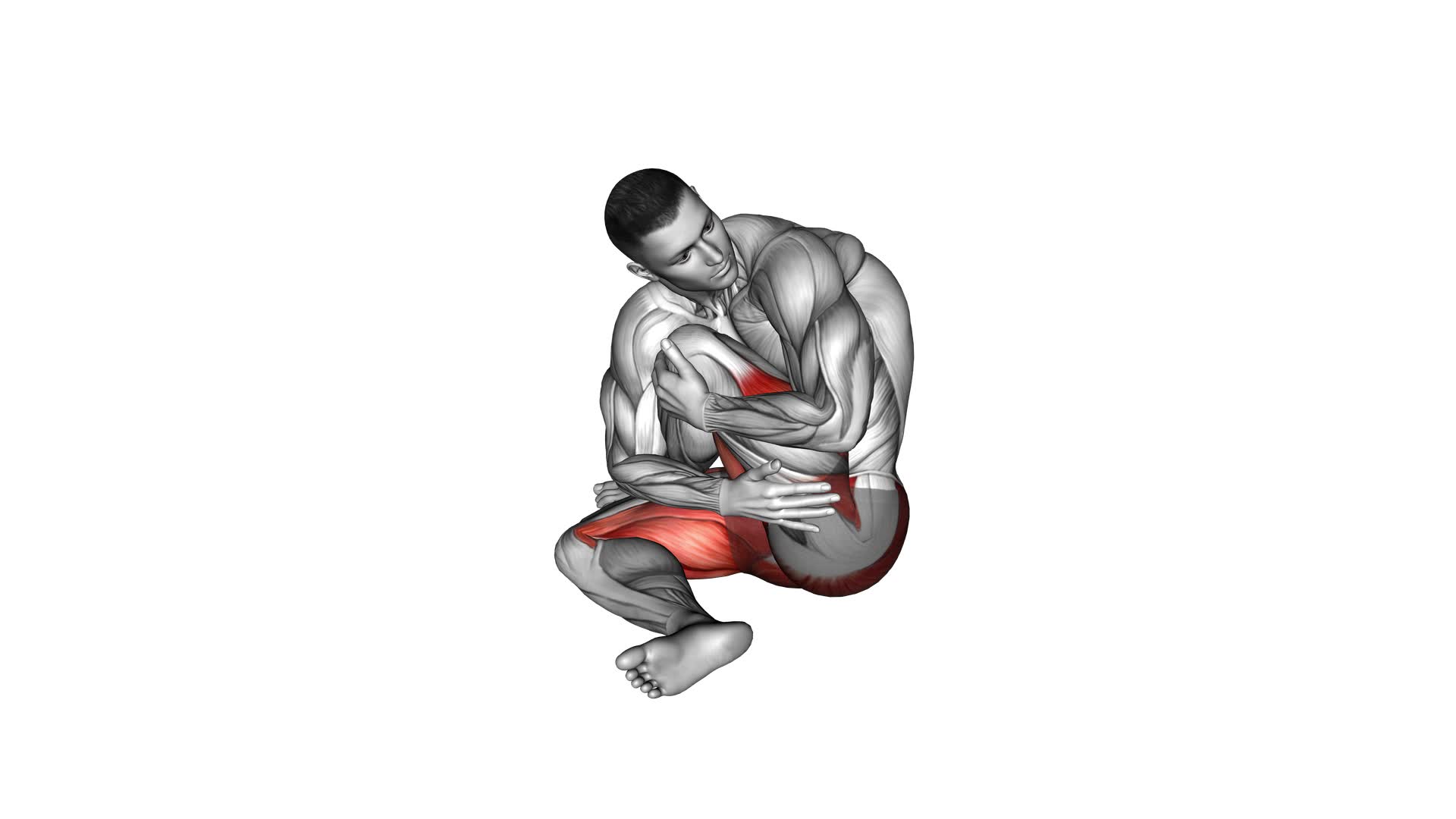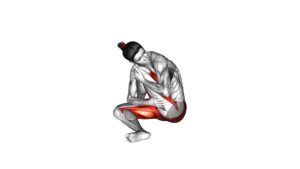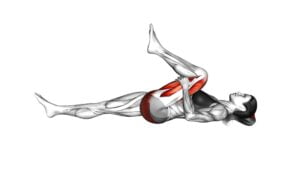Knee Hug Glute Stretch (male) – Video Exercise Guide & Tips

Are you looking for a quick and effective way to stretch your glutes? Look no further than the knee hug glute stretch!
Watch This Exercise Video
This exercise is perfect for men who want to target their glute muscles.
In this video exercise guide, we will show you the proper form and technique for this stretch, as well as modifications for different fitness levels.
Avoid common mistakes and maximize the effectiveness of this stretch with our helpful tips.
Let's get started!
Key Takeaways
- The Knee Hug Glute Stretch improves flexibility and reduces muscle tension in the glutes.
- Proper form and technique involve lying on your back, bending one knee, and gently pulling it towards your chest while keeping the other leg straight and relaxed.
- Modifications and variations can be made based on different fitness levels, such as bringing the knee up towards the chest or twisting the upper body in the opposite direction.
- Common mistakes to avoid include rounding the back, applying excessive tension, and failing to engage core muscles.
Benefits of the Knee Hug Glute Stretch
You can experience improved flexibility and reduced muscle tension in your glutes with the Knee Hug Glute Stretch. This stretch is highly effective in maximizing flexibility and preventing injuries in your glute muscles. By performing this stretch regularly, you can help maintain a full range of motion in your hips and improve overall flexibility in your lower body.
The Knee Hug Glute Stretch specifically targets the glute muscles, which play a crucial role in many movements such as walking, running, and squatting. By stretching these muscles, you can prevent tightness and potential injuries, such as strains or pulls.
To perform the Knee Hug Glute Stretch, start by lying on your back with your legs extended. Bend one knee and hug it towards your chest, feeling a gentle stretch in your glute muscles. Hold the stretch for 20-30 seconds and then switch to the other leg.
Incorporating the Knee Hug Glute Stretch into your regular exercise routine can help improve your flexibility, reduce muscle tension, and prevent injuries in your glutes. Remember to always listen to your body and consult with a professional if you experience any pain or discomfort during the stretch.
Proper Form and Technique for the Stretch
To perform the Knee Hug Glute Stretch with proper form and technique, start by lying on your back with your legs extended. Bend one knee and bring it towards your chest, using both hands to hold onto your shin or behind your thigh. Keep your other leg straight and relaxed on the ground. This is the starting position for the stretch.
Once you're in the starting position, gently pull your bent knee towards your chest until you feel a comfortable stretch in your glute muscles. Hold this position for 20-30 seconds, focusing on relaxing your muscles and breathing deeply.
To modify this stretch, you can use a strap or towel to help pull your knee closer to your chest if you have limited flexibility. You can also experiment with different positions for your arms, such as placing them behind your head or reaching towards your toes, to intensify the stretch.
Remember to always listen to your body and avoid any pain or discomfort. If you're unsure about proper form or have any concerns, it's recommended to consult with a qualified fitness professional or physical therapist who can provide guidance on stretching techniques and modifications specific to your needs.
Modifications and Variations for Different Fitness Levels
Begin by selecting the appropriate modification or variation based on your fitness level. Here are three options to consider:
- Basic modification: If you're just starting out or have limited flexibility, you can begin by performing the knee hug glute stretch while lying on your back. Instead of hugging your knee towards your chest, simply bring your knee up towards your chest as far as you comfortably can. This modification allows you to focus on the stretch without putting too much strain on your muscles.
- Intermediate progression: Once you feel comfortable with the basic modification, you can progress to the standing knee hug glute stretch. This variation requires you to balance on one leg while bringing the opposite knee towards your chest. This adds an element of stability and strength to the stretch, engaging your core and glute muscles even further.
- Advanced modification: For those with advanced flexibility and strength, you can try the knee hug glute stretch with a twist. As you bring your knee towards your chest, twist your upper body in the opposite direction, reaching your opposite arm towards the extended leg. This variation adds an extra challenge by incorporating rotational movement and further activating your core and glutes.
By choosing the modification or variation that best suits your fitness level, you can ensure that you're safely and effectively stretching your glutes.
Now let's move on to the next section, which will cover common mistakes to avoid while performing the stretch.
Common Mistakes to Avoid While Performing the Stretch
When performing the Knee Hug Glute Stretch, it's important to maintain proper body alignment to maximize its effectiveness. Avoid rounding your back or hunching your shoulders, as this can lead to incorrect muscle activation and potential strain.
Additionally, be mindful of not applying excessive tension or force when hugging your knee towards your chest, as this can cause unnecessary strain on your lower back.
Proper Body Alignment
Maintain proper body alignment throughout the knee hug glute stretch to avoid common mistakes. Proper body alignment is essential for maximizing the effectiveness of this stretch and reaping its benefits.
Here are three key points to keep in mind:
- Stand tall: Start by standing with your feet hip-width apart, shoulders relaxed, and spine straight. Avoid slouching or arching your back, as this can compromise the stretch and lead to strain or injury.
- Engage your core: As you lift your knee towards your chest, remember to engage your core muscles. This will help stabilize your body and protect your lower back.
- Keep your hips level: Throughout the stretch, make sure to keep your hips level. Avoid leaning to one side or tilting your pelvis forward or backward. This will ensure that the stretch targets your glutes effectively without straining other muscles.
Following these guidelines will help you maintain proper body alignment and get the most out of your knee hug glute stretch.
Avoiding Excessive Tension
To avoid excessive tension and potential strain, ensure that you're maintaining proper body alignment throughout the knee hug glute stretch. This is crucial for maximizing flexibility and reaping the full benefits of the exercise.
When performing the knee hug glute stretch, it's important to keep your back straight and your core engaged. Avoid rounding your shoulders or arching your back, as this can lead to unnecessary tension in the muscles and potential injury.
Additionally, make sure to breathe deeply and relax into the stretch, allowing your muscles to gradually release and lengthen. Remember, the key to an effective stretch is to maintain proper alignment and listen to your body's limits.
Incorporating this stretch into your routine won't only improve flexibility but also promote overall body function and prevent potential injuries.
Tips for Maximizing the Effectiveness of the Stretch
To get the most out of this stretch, position your body in a way that allows for a deep contraction of the glute muscles. Here are some tips for maximizing the effectiveness of the knee hug glute stretch:
- Maintain proper form: Start by lying on your back with your legs extended. Bend one knee and bring it towards your chest, hugging it with both hands. Keep your back flat on the floor and your other leg straight. This position ensures that the glute muscles are properly engaged during the stretch.
- Increase the stretch gradually: As you hug your knee closer to your chest, you should feel a gentle stretch in your glute muscles. Don't force the stretch or push beyond your comfort zone. Instead, listen to your body and increase the stretch gradually over time.
- Breathe deeply and relax: While performing the knee hug glute stretch, focus on deep breathing. Inhale deeply through your nose and exhale slowly through your mouth. This helps to relax the muscles and increase flexibility.
Additional Exercises to Complement the Knee Hug Glute Stretch
To complement the Knee Hug Glute Stretch, there are three key exercises you can incorporate into your routine.
First, focus on hamstring strengthening exercises like deadlifts and hamstring curls to target the muscles in the back of your thighs.
Next, work on hip mobility drills such as hip circles and hip flexor stretches to improve your range of motion.
Finally, include core stability workouts like planks and bridges to enhance your overall stability and support for your glutes.
Hamstring Strengthening Exercises
You can strengthen your hamstrings with these additional exercises that complement the Knee Hug Glute Stretch. Incorporating hamstring strengthening exercises into your workout routine is essential for improving hamstring flexibility and preventing injuries.
Here are three exercises to help you target and strengthen your hamstrings:
- Deadlifts: This compound exercise engages multiple muscle groups, including the hamstrings. Start with a barbell on the ground, hinge at the hips, and lift the weight while keeping your back straight.
- Hamstring curls: Using a hamstring curl machine or resistance bands, lie face down and curl your legs towards your glutes. Focus on squeezing your hamstrings as you perform the movement.
- Romanian deadlifts: Similar to regular deadlifts, but with a focus on eccentric contraction. Hold a barbell or dumbbells in front of your thighs, hinge at the hips, and lower the weight down while keeping your back straight.
Incorporating these exercises into your routine will help strengthen your hamstrings, improve flexibility, and reduce the risk of injury.
Hip Mobility Drills
Improve your hip mobility with these drills that complement the Knee Hug Glute Stretch. Hip mobility exercises are essential for improving hip flexibility and ensuring proper movement and function in the hip joint.
One effective drill is the Hip Circles exercise. Start by standing with your feet shoulder-width apart. Place your hands on your hips and slowly rotate your hips in a circular motion, first clockwise and then counterclockwise.
Another great drill is the Standing Hip Flexor Stretch. Begin by standing upright and take a step forward with your right leg. Bend your right knee and lower your body into a lunge position. You should feel a stretch in the front of your left hip. Hold for 30 seconds and then switch sides.
Incorporating these hip mobility drills into your routine will help improve your hip flexibility and support overall lower body strength and stability.
Core Stability Workouts
To enhance the benefits of the Knee Hug Glute Stretch, incorporate these additional core stability workouts into your routine:
- Plank: Start by assuming a push-up position, with your forearms on the ground and your body in a straight line. Engage your core muscles and hold this position for as long as you can. The plank exercise helps to improve overall core stability and strength.
- Russian Twist: Sit on the ground with your knees bent and feet flat on the floor. Lean back slightly and lift your feet off the ground. Twist your torso from side to side, touching the ground with your hands on each side. This exercise targets the obliques and improves core stability.
- Dead Bug: Lie on your back with your arms extended towards the ceiling and your knees bent at a 90-degree angle. Slowly lower one arm and the opposite leg towards the ground, while keeping your core engaged. Return to the starting position and repeat on the other side. The dead bug exercise helps to activate the deep core muscles and improve core stability.
Incorporating these core stability workouts into your routine alongside the Knee Hug Glute Stretch will provide you with a well-rounded workout that targets your glutes and improves core stability.
Frequently Asked Questions
How Often Should I Perform the Knee Hug Glute Stretch?
To maximize the benefits of the knee hug glute stretch for flexibility, it's important to perform it regularly. You might be wondering, how often should I perform this stretch?
Well, the frequency depends on your individual needs and goals. Generally, it's recommended to incorporate this stretch into your routine 2-3 times per week. However, if you have specific flexibility goals or tightness in your glutes, you may benefit from performing it more frequently, even daily.
Can the Knee Hug Glute Stretch Help With Lower Back Pain?
The knee hug glute stretch is an effective exercise for improving flexibility and can potentially help with lower back pain. It targets the glute muscles, which play a crucial role in stabilizing the lower back.
Compared to other stretches, the knee hug glute stretch specifically targets the glutes, making it a targeted and effective stretch for lower back pain relief.
Incorporating this stretch into your routine can provide relief and improve flexibility in the lower back area.
Is It Normal to Feel Discomfort or Tightness in the Hip Flexors During the Stretch?
Feeling discomfort or tightness in your hip flexors during the knee hug glute stretch isn't uncommon. This stretch targets the glutes but also engages the hip flexors.
It's important to note that tight hip flexors can contribute to lower back pain, so incorporating hip flexor stretches and hip mobility exercises into your routine can help alleviate any discomfort.
Remember to listen to your body and adjust the stretch as needed to avoid any pain or strain.
Can the Knee Hug Glute Stretch Benefit Athletes and Weightlifters?
The knee hug glute stretch can be highly beneficial for athletes and weightlifters. It helps improve flexibility in the glutes and hip flexors, which are essential for optimal performance in sports and weightlifting.
This stretch can also be modified for beginners by starting with a smaller range of motion and gradually increasing it over time. By incorporating the knee hug glute stretch into your routine, you can enhance your overall athletic performance and prevent muscle imbalances or injuries.
Are There Any Precautions or Contraindications for Performing the Knee Hug Glute Stretch?
Before attempting the Knee Hug Glute Stretch, it's important to be aware of any precautions or contraindications. Certain individuals with knee or hip injuries, lower back pain, or balance issues should exercise caution and consult with a healthcare professional before performing this stretch.
Additionally, if you experience any discomfort, pain, or difficulties during the exercise, it's best to stop and seek guidance. Remember to always prioritize your safety and well-being when engaging in any fitness routine.
Conclusion
In conclusion, the knee hug glute stretch is a beneficial exercise for improving flexibility and mobility in the glute muscles. By maintaining proper form and technique, individuals can effectively stretch their glutes and reap the benefits of this exercise.
It's important to remember that modifications and variations can be made to accommodate different fitness levels. Avoiding common mistakes and following the provided tips will help maximize the effectiveness of this stretch.
Additionally, incorporating other complementary exercises into your routine can further enhance your overall fitness results.

Author
Years ago, the spark of my life’s passion ignited in my mind the moment I stepped into the local gym for the first time. The inaugural bead of perspiration, the initial endeavor, the very first surge of endorphins, and a sense of pride that washed over me post-workout marked the beginning of my deep-seated interest in strength sports, fitness, and sports nutrition. This very curiosity blossomed rapidly into a profound fascination, propelling me to earn a Master’s degree in Physical Education from the Academy of Physical Education in Krakow, followed by a Sports Manager diploma from the Jagiellonian University. My journey of growth led me to gain more specialized qualifications, such as being a certified personal trainer with a focus on sports dietetics, a lifeguard, and an instructor for wellness and corrective gymnastics. Theoretical knowledge paired seamlessly with practical experience, reinforcing my belief that the transformation of individuals under my guidance was also a reflection of my personal growth. This belief holds true even today. Each day, I strive to push the boundaries and explore new realms. These realms gently elevate me to greater heights. The unique combination of passion for my field and the continuous quest for growth fuels my drive to break new ground.



